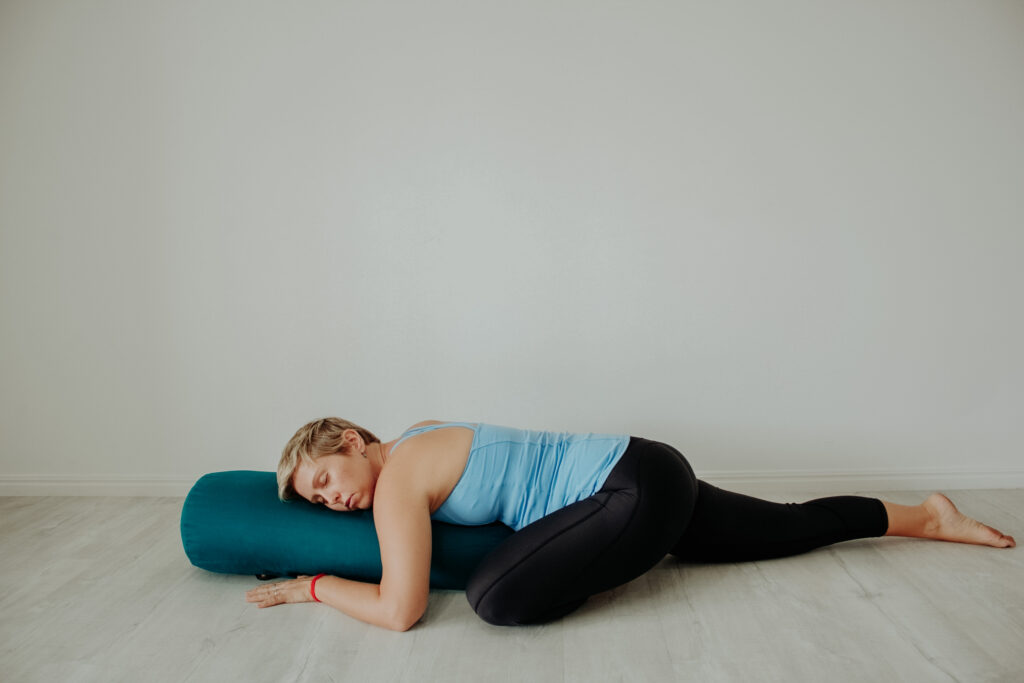Pigeon Pose during pregnancy – Pregnancy yoga pose spotlight
Pigeon pose during pregnancy has many benefits from helping to open the hips and pelvis to releasing stress and emotions. You will need to know how to modify your practice and use props to support your pigeon pose during pregnancy to avoid injury.
Please note, this blog post contains affiliate links. Any purchases made through these links will send me a tiny commission at no extra cost to you. Thank you for supporting my work.
Benefits of pigeon pose during pregnancy
- creates opening in the pelvis and increases hip mobility (both important for birth)
- stretches the psoas and hip flexors
- can help to relieve sciatica pain
- is a calming / grounding pose
When shouldn’t you practise pigeon pose?
With pelvic instability
If you’re experiencing any pelvic instability (SPD or SI pain) you should avoid pigeon pose. An unstable pelvis means you already have too much movement in these joints, and pigeon pose is working to increase this. Avoid pigeon pose if you have pelvic instability and choose narrow stance and strengthening poses instead.
During a sciatica flare up
While pigeon pose during pregnancy can help to stretch a tight sciatic nerve, during a sciatica flare up is not the time to attempt pigeon pose. Instead, work with a physio to relieve the pain and then pigeon pose may be used to stretch into this area.
What props should you use to practise pigeon pose during pregnancy?
Really tight hips.
Place blankets, blocks or bolsters under buttocks on the side of the bent knee if hips are really tight. This will provide support so that stretching is gentle, rather than intense. We should never aim for an intense stretch during pregnancy as the hormone relaxin is already working to allow the body to soften (too much stretching can cause injury).
Belly has become big and uncomfortable.
Place a bolster underneath the chest to allow you to rest forward and have space for the belly. This helps you to really soften into this pose, making it feel restorative.
Unable to move into the lying variation?
You can practise pigeon pose in a seated position using a chair or reclined on a bolster. These options allow you to move into the stretch that pigeon provides without feeling like you may get stuck on the floor!
How to practice pigeon pose during pregnancy
From tabletop pose, bring your right knee behind your right wrist. Tuck the right foot in towards your groin to make space for your belly.
Stretch the left leg out behind you. If this stretch feels too much, bring a prop underneath your right hip so that you can relax into the support.
Inhale, feel length in your spine and open your chest. As you exhale walk the hands forward and bring the chest down towards the floor. You can either rest the head on your arms, or bring a bolster underneath the chest for support.
What can you practice instead of pigeon pose during pregnancy?
Regular pigeon pose just not feeling good during pregnancy? That’s okay! You can practise a reclined variation with a bolster underneath your upper back to support you.
Recline on a bolster (or two if you have heart burn).
Bend your knees and bring the soles of your feet to the floor.
Place the left ankle just above the right knee and let the left knee fall away from you.
Stay here for five breaths before moving to the opposite side.
Which trimesters can you practise pigeon pose during pregnancy?
Pigeon pose is suitable during all trimesters, including postpartum.
When should you practise pigeon pose?
Pigeon pose is one of my favourite poses for when I’m feeling tired or emotional. When I’m teaching pregnancy yoga classes I usually include this pose towards the end of the class as we start to wind down into floor based poses before settling in to meditation.
If you’re brand new to practising pregnancy yoga you can download my free guide here.
Or if you’re a yoga teacher looking for information about teaching pregnancy yoga, you can download my free teaching guide and resources here.

